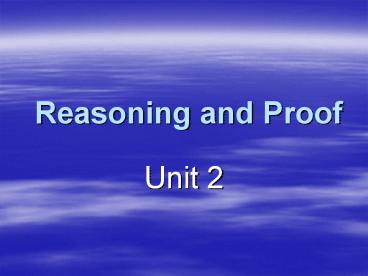Reasoning and Proof - PowerPoint PPT Presentation
1 / 37
Title:
Reasoning and Proof
Description:
Law of Syllogism. Law of Detachment ... Law of Syllogism ... Law of Syllogism. If p q and q r are True, then p r is True ... – PowerPoint PPT presentation
Number of Views:418
Avg rating:3.0/5.0
Title: Reasoning and Proof
1
Reasoning and Proof
- Unit 2
2
Inductive reasoning
Statements Logic
Reasoning and Proof
Proofs (Algebra, segments, angles)
Deductive reasoning
3
Inductive Reasoning
- Looking at specific situations to arrive at a
conjecture - Examples ? generalization
4
Deductive Reasoning
- Applying a generalization to specific
situations to arrive at a conjecture - Generalization ? examples
5
Conjecture
- An educated guess
- aka hypothesis
- a conclusion based on observations
6
Counterexample
- a false example
- only takes one to make a conjecture false
7
Conditional statement
- a statement in
- If-then form
- If- hypothesis
- -then conclusion
p ? q
8
Converse
- a statement in which the hypothesis and
conclusion are interchanged
q ? p
9
Negation
- the denial of a statement
- Usually includes a not in it
- Has the opposite truth value from the original
p ? q
10
Inverse
- a statement negating both the hypothesis and
conclusion of a statement
p ? q
11
Contrapositive
- a statement negating both the hypothesis and
conclusion of the converse
q ? p
12
Postulate
- a principle that is accepted without proof
- 6 basic postulates concerning points, lines, and
planes
13
Postulate 2-1
- Through any 2 points, there is exactly one line
14
Postulate 2-2
- Through any 3 non-collinear points, there is
exactly one plane
15
Postulate 2-3
- A line contains at least 2 points
16
Postulate 2-4
- A plane contains at least 3 non-collinear points
17
Postulate 2-5
- If 2 points lie in a plane, then the entire
line containing them lies in the plane
18
Postulate 2-6
- If 2 planes intersect, then their intersection
is a line
19
Deductive Reasoning
- 2 laws of logic used in proofs are
- Law of Detachment
- Law of Syllogism
20
Law of Detachment
- If a conditional and its hypothesis is true,
then the conclusion is true
If p ? q is T p is T, then q is T
21
Law of Syllogism
- If 2 conditionals in which the conclusion of
the 1st is the hypothesis of the 2nd are true,
then the conditional with the hypothesis of the
1st and the conclusion of the 2nd is also true
22
Law of Syllogism
If p ? q and q ? r are True, then p ? r is True
Similar to the transitive property in algebra
23
Properties of equality
- Reflexive
- Symmetric
- Transitive
- Addition subtraction
- Multiplication division
- Substitution
- Distributive
24
Properties of equality
- Reflexive
- a a
- Symmetric
- If a b, then b a
- Transitive
- If a b b c, then a c
25
Properties of equality
- Addition subtraction
- If a b, then a c b c
- Multiplication divison
- If a b, then ac bc
26
Properties of equality
- Substitution
- If a b, then
- a can be replaced with b
- Distributive
- a (b c) ab ac
27
Proof
A logical argument that shows that a certain true
hypothesis guarantees the truth of a certain
conclusion
28
Two-column proof
A formal proof with statements listed in one
column and reasons in another
29
Two-column proof
Given Figure Prove Statements
Reasons a. a. b. b. etc.
30
Theorem 2-1
- Congruence of segments is
- reflexive
- symmetric
- transitive
31
Theorem 2-2Supplement Theorem
If 2 angles form a linear pair, then they are
supplementary
32
Theorem 2-3
- Congruence of angles is
- reflexive
- symmetric
- transitive
33
Theorem 2-4
Angles supplementary to the same angle or two
congruent angles are congruent
34
Theorem 2-5
Angles complementary to the same angle or two
congruent angles are congruent
35
Theorem 2-6
All right angles are congruent
36
Theorem 2-7
Vertical angles are congruent
37
Theorem 2-8
Perpendicular lines intersect to form 4 right
angles































![⚡[PDF]✔ Body of Proof: The 7 Best Reasons to Believe in the Resurrection of Jesus--and PowerPoint PPT Presentation](https://s3.amazonaws.com/images.powershow.com/10042717.th0.jpg?_=20240530073)